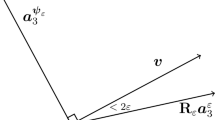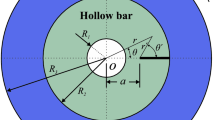The interaction of through, surface, and internal cracks in shells of arbitrary curvature is examined. Crack of the same and different types with various geometry are considered. The curvature of the shell, the length and depth of the cracks, their arrangement and distance between them have a strong effect on the stress intensity factors for part-through cracks and on the force and moment intensity factors for through cracks
Similar content being viewed by others
References
S. N. Atluri (ed.), Computational Methods in the Mechanics of Fracture, Elsevier, Amsterdam (1986).
E. N. Dovbnya and M. A. Chernyshenko, ”Stress–strain analysis of a shell of arbitrary curvature with three parallel surface cracks,” Tr. Inst. Prikl. Mat. Mekh., 12, 51–55 (2006).
K. M. Dovbnya and M. A. Chernyshenko, ”Stress state of shells with parallel surface cracks,” Prikl. Probl. Mekh. Mat., 4, 67–71 (2006).
K. M. Dovbnya and V. V. Yartemik, ”Using the line-spring model to study a shell of arbitrary curvature with an internal crack,” Mat. Met. Fiz.-Mekh. Polya, 50, No. 4, 160–164 (2007).
K. M. Dovbnya and V. V. Yartemik, ”Studying the SIF in a shell with a set of through and surface collinear cracks,” Tr. Inst. Prikl. Mat. Mekh., 13, 63–69 (2007).
E. N. Dovbnya and V. V. Yartemik, ”Interaction of through and part-through cracks in a shell of arbitrary curvature,” Teor. Osnovy Stroit., 16, 91–98 (2008).
R. M. Kushnir, M. M. Nikolyshyn, and V. A. Osadchuk, Elastic and Elastoplastic State of Shells with Defects [in Ukrainian], Spolokh, Lviv (2003).
R. Z. Stasyuk, ”Analyzing the disturbed stress state of a closed cylindrical shell with a set of transverse part-through cracks,” Mat. Met. Fiz.-Mekh. Polya, 37, 63–65 (1994).
R. Z. Stasyuk, ”Disturbed stress state of a closed cylindrical shell with longitudinal cracks on the inner surface,” Mat. Met. Fiz.-Mekh. Polya, 38, 85–88 (1995).
V. K. Khizhnyak and V. P. Shevchenko, Mixed Problems in the Theory of Plates and Shells: A Handbook [in Russian], Izd. DonGU, Donetsk (1980).
V. P. Shevchenko, “Methods of fundamental solutions in the theory of orthotropic shells,” in: Stress Concentration, Vol. 7 of the 12-volume series Mechanics of Composite Materials [in Russian], A.S.K., Kyiv (1998), pp. 159–196.
F. Delate and F. Erdogan, ”Application of the line-spring model to a cylindrical shell containing a circumferential or axial part-trough crack,” ASME, J. Appl.Mech., 49, 97–102 (1982).
F. Delate and F. Erdogan, ”Line-spring model for surface cracks in a Reissner plate,” Int. J. Eng. Sci., 19, 1331–1340 (1981).
J. R. Rice and N. Levy, ”The part-through surface crack in an elastic plate,” ASME, J. Appl. Mech., 39, No. 1, 185–194 (1972).
Author information
Authors and Affiliations
Corresponding author
Additional information
Translated from Prikladnaya Mekhanika, Vol. 47, No. 4, pp. 89–98, July 2011.
Rights and permissions
About this article
Cite this article
Shevchenko, V.P., Dovbnya, E.N. & Yartemik, V.V. Shell of arbitrary curvature with cracks of different type and geometry. Int Appl Mech 47, 422–430 (2011). https://doi.org/10.1007/s10778-011-0468-8
Received:
Published:
Issue Date:
DOI: https://doi.org/10.1007/s10778-011-0468-8




